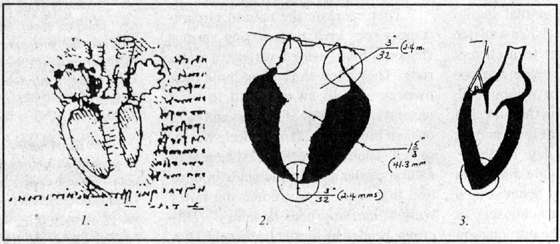To any doctor trained in today’s medical schools, the idea that the heart may not be a pump would, at first sight, appear to be about as logical as suggesting that the sun rises in the West or that water flows uphill. So strongly is the pump concept ingrained in the collective psyche that even trying to think otherwise is more than most people can manage. Yet Rudolf Steiner, a man not given to unscientific or slipshod thinking, was quite clear on the matter and reiterated time and again that the heart is not a pump. “The blood drives the heart, not the heart the blood.”
Misleading sketch of the heart by Leonardo do Vinci (1). The left ventricle wall is shown uniform in thickness as it would he in a pressure chamber. Actually the left ventricle wall thickness varies by about 1800% as Marinelli and his group measured in bovine hearts (2). The apex wall is so soft and weak that it can be pierced with the index finger. The peculiar variability in the ventricular wall thickness is not in keeping with the heart as pressure generator. However, Leonardo’s Notebooks has been used in most biology, physiology, and medical texts during the last few hundred years as well as in most modern anatomy texts in the last decades (3). Thus, false sketches have served to bear witness to a false premise.
Recently Ralph Marinelli* and his co-workers published a paper refuting the generally-accepted pressure-propulsion premise. For a start, they draw attention to the sheer volume of work which the heart would have to do if it were solely responsible for pumping inert blood through the vessels of the circulatory system. Blood is five times as viscous as water. According to the propulsion premise the heart would have to pump 8000 liters of blood a day in a body at rest and considerably more during activity, through millions of capillaries the diameters of which are sometimes smaller than the red blood cells themselves – a huge task for a relatively small, muscular organ weighing only 300 grams.
Once the questions start being asked, the anomalies in currently accepted dogma become apparent. For instance, if blood were pumped under pressure out of the left ventricle into the aorta during systole, the pressure pulse would cause the aortic arch to try and straighten out, as happens in any Bourdon tube pressure gauge. In practice the exact opposite happens; the curve increases, indicating that the aorta is undergoing a negative, rather than a positive, pressure.
Another paradoxical finding concerns the mechanics of fluid flow under pulsatile pressure. When a pressure pulse is applied to a viscous fluid in a closed vessel, the liquid initially resists movement through its own inertia. The pressure, therefore, peaks before the fluid velocity peaks. In the aorta, exactly the opposite happens where a peak flow markedly precedes peak pressure, a fact which was observed in 1860 by Chaveau and Lortet. So just what is going on inside the circulation?
As Marinelli et al point out, the pressure-propulsion model of blood circulation rests on four major premises: (1) blood is naturally inert and must, therefore, be forced to circulate; (2) there is a random mix of formed particles in the blood; (3) blood cells are under pressure at all times; (4) blood is amorphous and is forced to fill its vessels and take on their form.
All of these premises can be shown to be faulty. For example, far from having a random mix of the blood components in vessels, the cellular elements arrange themselves in a highly organized flow pattern in which the heavier red blood cells flow nearest to the axis of the vessels while the lighter platelets are nearer to the periphery. All of the formed elements are surrounded by a sleeve of plasma which is in contact with the vessel wall. However, a major misconception about how blood circulates is the assumption that it flows in a laminar fashion, whereas in reality the main pattern appears to be a vortex. This leads to a whole new concept of circulatory dynamics–one which goes a long way towards explaining the close interaction between the heart and the blood– both of which are derived from the same embryonic material.
Clues to circulatory physiology are found in embryology. Two of the main embryological observations have been that the blood starts circulating before the heart has been fully formed and that it circulates in a spiraling fashion, as in the single-stage tube heart of the chick before the valves have developed.
Why are we concerned about the way in which the blood circulates and the `heart as a pump’ paradox? Do we not already know enough about circulation in conventional terms for all practical purposes? No. Is all this really relevant? Yes. Not only should truth be sought for its own sake, but therapy based upon faulty premises can only be bad therapy.
Reprinted with permission from the Journal of Anthroposophical Medicine, Volume 13, Spring 1996.
References
- Steiner, R.,Welche Bedeutung hat die okkulte Entwicklung des Menschen fuer seine Huellen.. und sein Selbst?2nd Lecture
- Husemann F., Wolff, O.,The Anthroposophical Approach to Medicine Vol.II, 1989, New York., Anthroposophic Press, p.342.
- Marinelli R., Furst, B., van der Goe H., McGinn A., Marinelli W.The Heart is Not a Pump: A Refutation of the Pressure Propulsion Premise of Heart Function. Frontier Perspectives, 1995, 5: 15-24. Stonebridge P.A.,
- Brophy C.M.,Spiral Flow in Arteries?Lancet 1991.338: 1360-1361.
- Steiner R.,Spiritual Science and Medicine, 1920. Rudolf Steiner Press, London, 24-25.
* Mr. Marinelli writes:
Our ultimate aim is to demonstrate as much as we can of the heart’s consciousness. We have already made interesting progress in this direction. The embryologist Bremer had shown, but failed himself to see, that both blood and heart express conscious functions. He took movies of the two blood streams traveling in the single tube stage of heart formation and this is what he saw: each stream spiraling around its own longitudinal axis and both streams spiraling around each other in graceful motion. This tells us that the blood streams can navigate; they know where they are, where they want to go and how they will get there. The streams do not collide, travel at different velocities but arrive at the same time at their destination.
The embryonic heart also demonstrates its consciousness: when the blood enters the heart, the heart senses the spiraling motion of the blood, mimics it and times its impulse to boost the blood motion to maximize energy transfer and minimize disturbance to the blood flow pattern. The heart’s engagement of the blood is beautifully in phase.
Of course the well-known blushing and blanching of the cheeks in shame and fear respectively told us long ago that the blood reacts to the motions of the soul.
The heart is not a pressure pump nor is it a metaphor. It is the seat of good and evil. Its noble reality is implied by Christ’s references to it, “Let not your heart be troubled: ye believe in God, Believe also in me.”
Ralph Marinelli
Rudolf Steiner Research Center
2825 Vinsetta
Royal Oak, MI 48073
Correspondence welcome.

